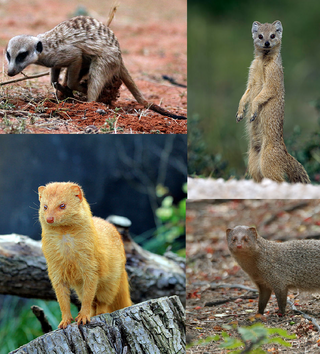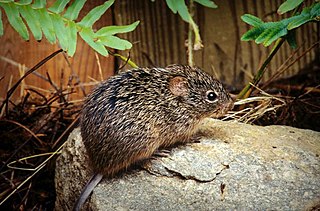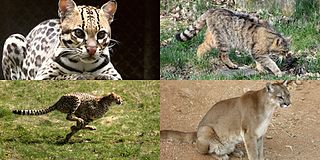
Felidae is the family of mammals in the order Carnivora colloquially referred to as cats. A member of this family is also called a felid.

The tiger is a member of the genus Panthera and the largest living cat species native to Asia. It has a powerful, muscular body with a large head and paws, a long tail and orange fur with black, mostly vertical stripes. It is traditionally classified into nine recent subspecies, though some recognise only two subspecies, mainland Asian tigers and the island tigers of the Sunda Islands.

A mongoose is a small terrestrial carnivorous mammal belonging to the family Herpestidae. This family has two subfamilies, the Herpestinae and the Mungotinae. The Herpestinae comprises 23 living species that are native to southern Europe, Africa and Asia, whereas the Mungotinae comprises 11 species native to Africa. The Herpestidae originated about 21.8 ± 3.6 million years ago in the Early Miocene and genetically diverged into two main genetic lineages between 19.1 and 18.5 ± 3.5 million years ago.

The rodent subfamily Sigmodontinae includes New World rats and mice, with at least 376 species. Many authorities include the Neotominae and Tylomyinae as part of a larger definition of Sigmodontinae. When those genera are included, the species count numbers at least 508. Their distribution includes much of the New World, but the genera are predominantly South American, such as brucies. They invaded South America from Central America as part of the Great American Interchange near the end of the Miocene, about 5 million years ago. Sigmodontines proceeded to diversify explosively in the formerly isolated continent. They inhabit many of the same ecological niches that the Murinae occupy in the Old World.

The New World rats and mice are a group of related rodents found in North and South America. They are extremely diverse in appearance and ecology, ranging from the tiny Baiomys to the large Kunsia. They represent one of the few examples of muroid rodents in North America, and the only example of muroid rodents to have made it into South America.

Apodemus is a genus of Muridae. The name is unrelated to that of the Mus genus, instead being derived from the Greek ἀπό-δημος.

Felinae is a subfamily of the Felidae and comprises the small cats having a bony hyoid, because of which they are able to purr but not roar. Other authors have proposed an alternative definition for this subfamily, as comprising only the living conical-toothed cat genera with two tribes, the Felini and Pantherini, and excluding the extinct sabre-toothed Machairodontinae.

Batomys is a genus of rodent endemic to the Philippines. It has six extant described species.

Tokudaia is a genus of murine rodent native to Japan. Known as Ryūkyū spiny rats or spinous country-rats, population groups exist on several non-contiguous islands. Despite differences in name and appearance, they are the closest living relatives of the Eurasian field mouse (Apodemus). Of the three species, both T. osimensis and T. tokunoshimensis have lost their Y chromosome and SRY gene; the sex chromosomes of T. muenninki, on the other hand, are abnormally large.
The large-eared vole is a species of rodent in the family Cricetidae. It is found in Mongolia and the Russian Federation.

The southern big-eared mouse, also known as the southern pericote, is a species of rodent in the family Cricetidae. It is found in Argentina and Chile, and is one of only two species in its genus. The type specimen was captured by Charles Darwin in 1834 along the Santa Cruz River in Argentina, during the voyage of HMS Beagle, and was subsequently described by George Robert Waterhouse.
Robert's snow vole is a species of rodent in the family Cricetidae. It is found in Azerbaijan, Georgia, the Russian Federation, and Turkey. Its natural habitats are temperate forests and temperate grassland.

Nectomys is a genus of rodent in the tribe Oryzomyini of family Cricetidae. It is closely related to Amphinectomys and was formerly considered congeneric with Sigmodontomys. It consists of five species, which are allopatrically distributed across much of South America: Nectomys grandis in montane Colombia; Nectomys palmipes on Trinidad and in nearby Venezuela, Nectomys apicalis in the western margins of the Amazon biome, Nectomys rattus in much of Amazonia, and Nectomys squamipes in the Atlantic Forest of Brazil. These species are generally semiaquatic, are normally found near water, and are commonly called water rats.

Phyllotis is a genus of rodent in the family Cricetidae. These mice are commonly confused with Auliscomys, Graomys and Loxodontomys.. In order to tell these genera apart, one must look at the tail. Species in the genus Phyllotis have a penicillate tip on their tail which is not present in the other two genera. Tails in the genus Phyllotis are also less than the length of its head and body combined whereas in Graomys, tails are longer than the head and body combined. Phyllotis xanthopygus was found at the summit of Volcán Llullaillaco, which is the highest altitude a mammal has yet been found in nature.
Nectomys grandis, also known as the Magdalena-Cauca water rat, is a nocturnal, semiaquatic species of rodent in the genus Nectomys of family Cricetidae. It is found in western and northern Colombia at altitudes from sea level to 2000 m, including the basins of the Magdalena, Cauca and Porce rivers. It has two subspecies, N. g. grandis and N. g. magdalenae.

A species is often defined as the largest group of organisms in which any two individuals of the appropriate sexes or mating types can produce fertile offspring, typically by sexual reproduction. It is the basic unit of classification and a taxonomic rank of an organism, as well as a unit of biodiversity. Other ways of defining species include their karyotype, DNA sequence, morphology, behaviour, or ecological niche. In addition, paleontologists use the concept of the chronospecies since fossil reproduction cannot be examined. The most recent rigorous estimate for the total number of species of eukaryotes is between 8 and 8.7 million. About 14% of these had been described by 2011. All species are given a two-part name, a "binomial". The first part of a binomial is the genus to which the species belongs. The second part is called the specific name or the specific epithet. For example, Boa constrictor is one of the species of the genus Boa, with constrictor being the species' epithet.
The Pikumche pericote is a species of rodent in the family Cricetidae. It is known only from central Chile, where its range includes xeric shrublands.
Guy Graham Musser was an American zoologist. His main research was in the field of the rodent subfamily Murinae, in which he has described many new species.

In rodents, incisor procumbency refers to the orientation of the upper incisor, defined by the position of the cutting edge of the incisor relative to the vertical plane of the incisors. Proodont incisors have the cutting edge in front of the vertical plane, orthodont teeth have it perpendicular to the plane, opisthodont incisors have it behind the plane, and hyper-opisthodont teeth have the cutting edge even behind the back of the alveolus of the incisor.













